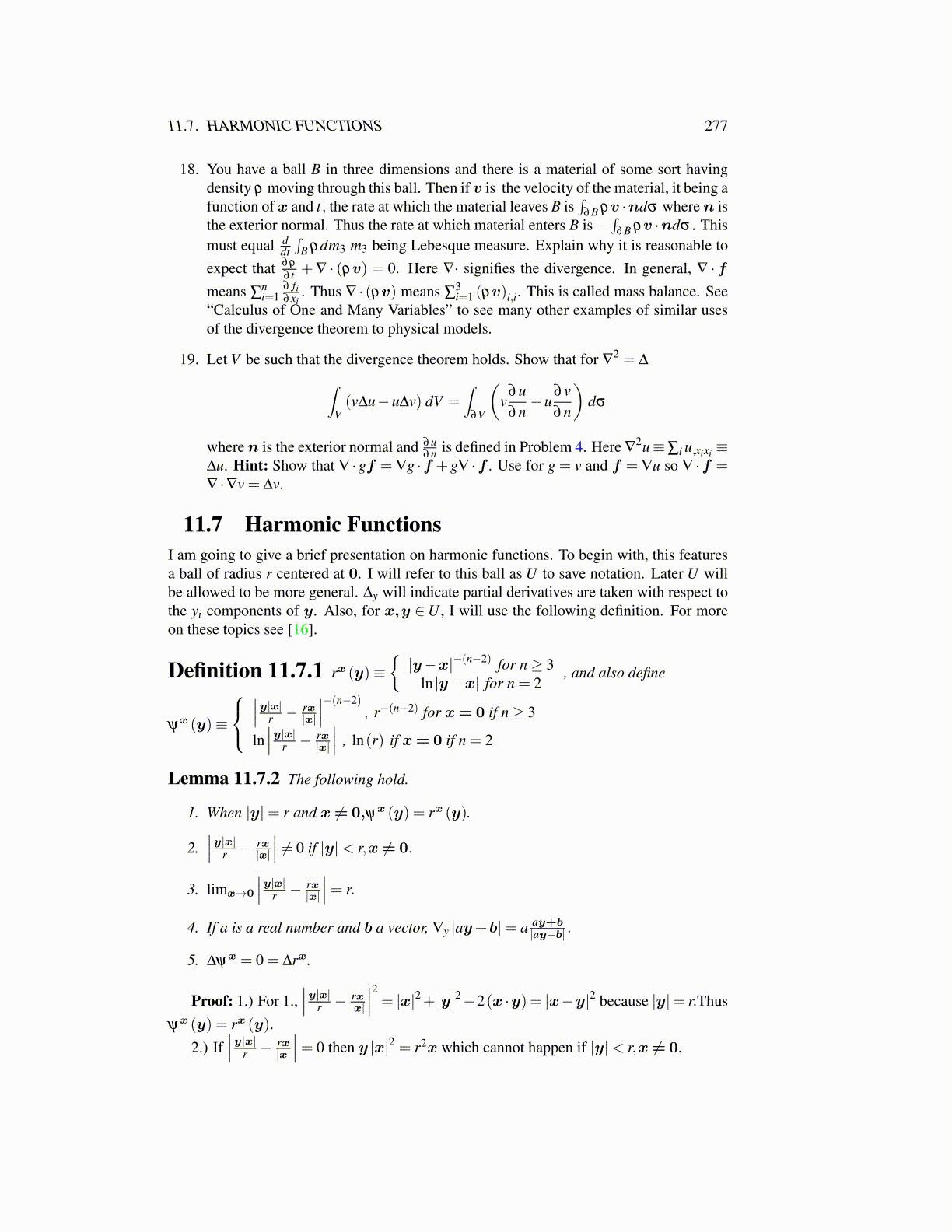
11.7. HARMONIC FUNCTIONS 277
18. You have a ball B in three dimensions and there is a material of some sort havingdensity ρ moving through this ball. Then if v is the velocity of the material, it being afunction of x and t, the rate at which the material leaves B is
∫∂B ρv ·ndσ where n is
the exterior normal. Thus the rate at which material enters B is −∫
∂B ρv ·ndσ . Thismust equal d
dt∫
B ρdm3 m3 being Lebesque measure. Explain why it is reasonable toexpect that ∂ρ
∂ t +∇ · (ρv) = 0. Here ∇· signifies the divergence. In general, ∇ ·fmeans ∑
ni=1
∂ fi∂xi
. Thus ∇ · (ρv) means ∑3i=1 (ρv)i,i. This is called mass balance. See
“Calculus of One and Many Variables” to see many other examples of similar usesof the divergence theorem to physical models.
19. Let V be such that the divergence theorem holds. Show that for ∇2 = ∆∫
V(v∆u−u∆v) dV =
∫∂V
(v
∂u∂n−u
∂v∂n
)dσ
where n is the exterior normal and ∂u∂n is defined in Problem 4. Here ∇
2u≡∑i u,xixi ≡∆u. Hint: Show that ∇ ·gf = ∇g ·f +g∇ ·f . Use for g = v and f = ∇u so ∇ ·f =∇ ·∇v = ∆v.
11.7 Harmonic FunctionsI am going to give a brief presentation on harmonic functions. To begin with, this featuresa ball of radius r centered at 0. I will refer to this ball as U to save notation. Later U willbe allowed to be more general. ∆y will indicate partial derivatives are taken with respect tothe yi components of y. Also, for x,y ∈U , I will use the following definition. For moreon these topics see [16].
Definition 11.7.1 rx (y)≡{|y−x|−(n−2) for n≥ 3
ln |y−x| for n = 2, and also define
ψx (y)≡
∣∣∣y|x|r −
rx|x|
∣∣∣−(n−2), r−(n−2) for x= 0 if n≥ 3
ln∣∣∣y|x|r −
rx|x|
∣∣∣ , ln(r) if x= 0 if n = 2
Lemma 11.7.2 The following hold.
1. When |y|= r and x ̸= 0,ψx (y) = rx (y).
2.∣∣∣y|x|r −
rx|x|
∣∣∣ ̸= 0 if |y|< r,x ̸= 0.
3. limx→0
∣∣∣y|x|r −rx|x|
∣∣∣= r.
4. If a is a real number and b a vector, ∇y |ay+b|= a ay+b|ay+b| .
5. ∆ψx = 0 = ∆rx.
Proof: 1.) For 1.,∣∣∣y|x|r −
rx|x|
∣∣∣2 = |x|2+ |y|2−2(x ·y) = |x−y|2 because |y|= r.Thusψx (y) = rx (y).
2.) If∣∣∣y|x|r −
rx|x|
∣∣∣= 0 then y |x|2 = r2x which cannot happen if |y|< r,x ̸= 0.